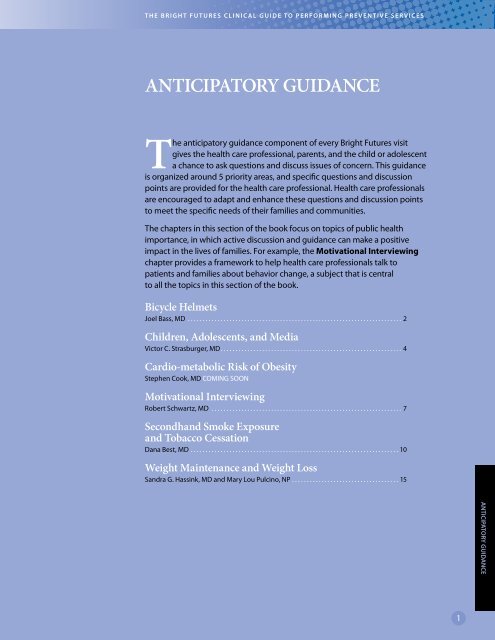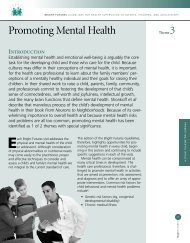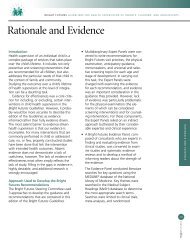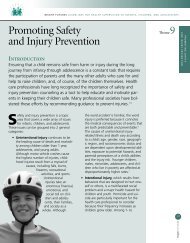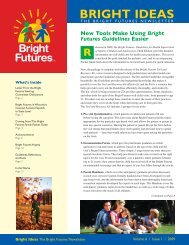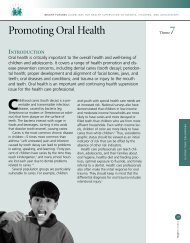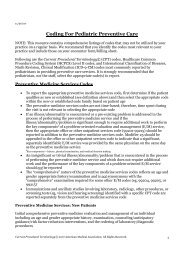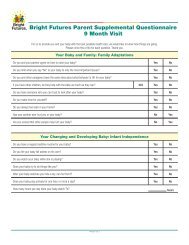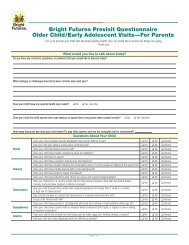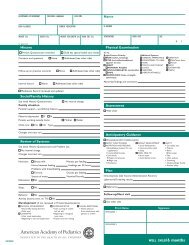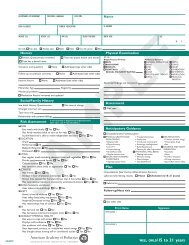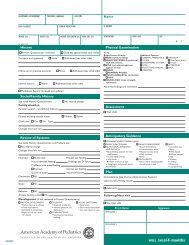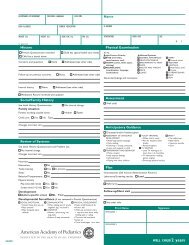ANTICIPATORY GUIDANCE - Bright Futures - American Academy of ...
ANTICIPATORY GUIDANCE - Bright Futures - American Academy of ...
ANTICIPATORY GUIDANCE - Bright Futures - American Academy of ...
You also want an ePaper? Increase the reach of your titles
YUMPU automatically turns print PDFs into web optimized ePapers that Google loves.
T H E B R I G H T F U T U R E S C L I N I C A L G U I D E TO P E R F O R M I N G P R E V E N T I V E S E R V I C E S<br />
<strong>ANTICIPATORY</strong> <strong>GUIDANCE</strong><br />
The anticipatory guidance component <strong>of</strong> every <strong>Bright</strong> <strong>Futures</strong> visit<br />
gives the health care pr<strong>of</strong>essional, parents, and the child or adolescent<br />
a chance to ask questions and discuss issues <strong>of</strong> concern. This guidance<br />
is organized around 5 priority areas, and specific questions and discussion<br />
points are provided for the health care pr<strong>of</strong>essional. Health care pr<strong>of</strong>essionals<br />
are encouraged to adapt and enhance these questions and discussion points<br />
to meet the specific needs <strong>of</strong> their families and communities.<br />
The chapters in this section <strong>of</strong> the book focus on topics <strong>of</strong> public health<br />
importance, in which active discussion and guidance can make a positive<br />
impact in the lives <strong>of</strong> families. For example, the Motivational Interviewing<br />
chapter provides a framework to help health care pr<strong>of</strong>essionals talk to<br />
patients and families about behavior change, a subject that is central<br />
to all the topics in this section <strong>of</strong> the book.<br />
Bicycle Helmets<br />
Joel Bass, MD . . . . . . . . . . . . . . . . . . . . . . . . . . . . . . . . . . . . . . . . . . . . . . . . . . . . . . . . . . . . . . . . . . . . . . . . 2<br />
Children, Adolescents, and Media<br />
Victor C. Strasburger, MD. . . . . . . . . . . . . . . . . . . . . . . . . . . . . . . . . . . . . . . . . . . . . . . . . . . . . . . . . . . . . 4<br />
Cardio-metabolic Risk <strong>of</strong> Obesity<br />
Stephen Cook, MD COMING SOON<br />
Motivational Interviewing<br />
Robert Schwartz, MD . . . . . . . . . . . . . . . . . . . . . . . . . . . . . . . . . . . . . . . . . . . . . . . . . . . . . . . . . . . . . . . . 7<br />
Secondhand Smoke Exposure<br />
and Tobacco Cessation<br />
Dana Best, MD . . . . . . . . . . . . . . . . . . . . . . . . . . . . . . . . . . . . . . . . . . . . . . . . . . . . . . . . . . . . . . . . . . . . . . 10<br />
Weight Maintenance and Weight Loss<br />
Sandra G. Hassink, MD and Mary Lou Pulcino, NP . . . . . . . . . . . . . . . . . . . . . . . . . . . . . . . . . . . . 15<br />
1<br />
<strong>ANTICIPATORY</strong> <strong>GUIDANCE</strong>
Why Is It Important to Include Bicycle<br />
Helmets in Anticipatory Guidance?<br />
Many children and youth love to bicycle but they<br />
don’t always wear a helmet. Bicycling is a popular<br />
recreational activity in the United States, particularly<br />
among children. It is estimated that 33 million children<br />
ride bicycles for nearly 10 billion hours each year.<br />
Unfortunately, only 15% <strong>of</strong> children use helmets all or<br />
most <strong>of</strong> the time while cycling. 1<br />
Bicycle-related injuries are common. Every year, about<br />
450,000 children are treated in emergency departments<br />
for bicycle-related injuries. Of the injuries, 153,000 are for<br />
head injuries. These head injuries are <strong>of</strong>ten very serious<br />
and account for most bicycle-related deaths.<br />
Many <strong>of</strong> the nonfatal injuries also are <strong>of</strong> great<br />
consequence, <strong>of</strong>ten producing lifelong disability<br />
associated with brain damage. 2<br />
Bicycle helmets protect children. It is well established<br />
that bicycle helmets are effective in preventing head<br />
injuries associated with bicycling. Overall, helmets<br />
decrease the risk <strong>of</strong> head and brain injury by about 80%.<br />
The risk <strong>of</strong> facial injuries to the upper and mid face is<br />
reduced by 65%.<br />
Counseling and safety programs can increase helmet<br />
use. Although not specific to bicycle helmet counseling,<br />
injury prevention counseling <strong>of</strong> parents <strong>of</strong> young children<br />
in the primary care setting has been shown to result in<br />
enhanced educational and behavioral outcomes. In some<br />
cases, it has resulted in decreased injuries. 3<br />
T H E B R I G H T F U T U R E S C L I N I C A L G U I D E TO P E R F O R M I N G P R E V E N T I V E S E R V I C E S<br />
JOEL BASS, md<br />
BICYCLE HELMETS<br />
Effective programs directed specifically at increasing the<br />
use <strong>of</strong> bicycle helmets in children have leveraged the<br />
synergy <strong>of</strong> legislation, community-based initiatives, and<br />
economic incentives. 4 One report, which also included<br />
reinforcing community initiatives with advice from<br />
pediatric practices, resulted in a significant increase in<br />
helmet use. 5<br />
How Should You Provide Anticipatory<br />
Guidance About Bicycle Helmets?<br />
Urge parents to<br />
••Check that the helmet meets the bicycle safety<br />
standards <strong>of</strong> the Consumer Product Safety<br />
Commission.<br />
••Fit the helmet squarely on top <strong>of</strong> the child’s head,<br />
covering the forehead. Be certain that it does not move<br />
around on the head or slide down. Adjust the chin<br />
strap to a snug fit.<br />
••Be certain that the child wears the helmet every time<br />
he or she rides the bike.<br />
••Serve as a model for the child. Parents also should<br />
always wear a helmet when bicycle riding.<br />
Use materials from the <strong>American</strong> <strong>Academy</strong> <strong>of</strong> Pediatrics<br />
(AAP) Injury Prevention Program (TIPP) to enhance your<br />
counseling. The TIPP sheets “About Bicycle Helmets” and<br />
“Tips for Getting Your Children to Wear Bicycle Helmets”<br />
have additional educational points.<br />
Consider performing an actual assessment <strong>of</strong> the helmet<br />
in your <strong>of</strong>fice. It can provide further reinforcement and<br />
education about bicycle helmets. 6<br />
2<br />
<strong>ANTICIPATORY</strong> <strong>GUIDANCE</strong>
B I C YC L E H E L M E T S<br />
What Anticipatory Guidance Should You<br />
Provide if You Encounter Resistance to<br />
Helmet Use?<br />
Give parents who do not require their children to use a<br />
helmet extensive information about the risks <strong>of</strong> bicyclerelated<br />
head injuries, including the TIPP sheets and details<br />
<strong>of</strong> state or local legislation or regulations.<br />
Whenever available, provide discount coupons for<br />
approved helmets. If your community has an active<br />
helmet program, they may provide access to free helmets<br />
under certain circumstances.<br />
Children who answer that they do not use a bicycle<br />
helmet should be given information appropriate to their<br />
age and cognitive level on the need for helmets. Materials<br />
for children from ongoing state or local community<br />
programs also may be available.<br />
What Results Should You document?<br />
Documentation <strong>of</strong> counseling efforts is always<br />
recommended. The physician copies <strong>of</strong> the Framingham<br />
Safety Surveys also are useful for documentation and to<br />
identify patients who would benefit from reviewing the<br />
issue <strong>of</strong> helmet use at subsequent visits.<br />
CPT and ICD-9-CM Codes<br />
99401 Preventive medicine counseling or risk<br />
factor reduction intervention(s) provided<br />
to an individual; approximately 15<br />
minutes.<br />
The <strong>American</strong> <strong>Academy</strong> <strong>of</strong> Pediatrics publishes a complete line <strong>of</strong> coding publications<br />
including an annual edition <strong>of</strong> Coding for Pediatrics. For more information on these<br />
excellent resources, visit the <strong>American</strong> <strong>Academy</strong> <strong>of</strong> Pediatrics online bookstore at<br />
www.aap.org/bookstore/.<br />
Resources<br />
Tools<br />
The AAP TIPP Program has injury prevention counseling<br />
questionnaires, including the Framingham Safety Survey:<br />
From 5 to 9 Years and from 10 to 12 Years. This survey<br />
covers the issue <strong>of</strong> bicycle helmet use. The 5 to 9 Years<br />
survey is completed by the parent and the 10 to 12 Years<br />
3 P R E V E N T I V E S E R V I C E S M A N UA L<br />
survey is completed by the child. Each survey includes<br />
a physician copy in which at-risk responses are easily<br />
identified. 7 This provides a useful, interactive method<br />
to counsel parents and children and also provides<br />
documentation <strong>of</strong> the counseling process.<br />
Web Sites<br />
<strong>American</strong> <strong>Academy</strong> <strong>of</strong> Pediatrics: http://www.aap.org/<br />
Bicycle Helmet Safety Institute http://www.bhsi.org/<br />
index.htm<br />
Centers for Disease Control and Prevention: http://www.<br />
cdc.gov/<br />
Harborview Injury Prevention and Research Center: http://<br />
depts.washington.edu/hiprc/<br />
References<br />
1. Bicycle injury interventions: bicycle helmet effectiveness.<br />
Harborview Injury Prevention & Research Center Web Site. 2001.<br />
http://depts.washington.edu/hiprc/practices/topic/bicycles/<br />
helmeteffect.html<br />
2. Injury-Control Recommendations: Bicycle Helmets. MMWR,<br />
44(16), 325 (1995). available at: cdc.gov/.mmwr/preview/<br />
mmwrhtml/00036941.htm<br />
3. Bass JL, Christ<strong>of</strong>fel KK, Widome MW, et al. Childhood injury<br />
prevention counseling in primary care settings: a critical review <strong>of</strong><br />
the literature. Pediatrics. 1993;92:544–550<br />
4. Bicycle injury interventions: programs to increase helmet use.<br />
Harborview Injury Prevention & Research Center Web Site. 2001.<br />
http://depts.washington.edu/hiprc/practices/topic/bicycles/<br />
helmeteduc.html<br />
5. Abularrage JJ, DeLuca AJ, Abularrage CJ. Effect <strong>of</strong> education and<br />
legislation on bicycle helmet use in a multiracial population. Arch<br />
Pediatr Adolesc Med. 1997;151:41–44<br />
6. Parkinson GW, Hike KE. Bicycle helmet assessment during well<br />
visits reveals severe shortcomings in condition and fit. Pediatrics.<br />
2003;112:320–323<br />
7. <strong>American</strong> <strong>Academy</strong> <strong>of</strong> Pediatrics Committee and Section on Injury,<br />
Violence and Poison Prevention. TIPP: A Guide to Safety Counseling<br />
in Office Practice. Elk Grove Village, IL: <strong>American</strong> <strong>Academy</strong> <strong>of</strong><br />
Pediatrics; 1994
Why Is It Important to Include media<br />
Usage in Anticipatory Guidance?<br />
Children and teenagers spend more than 7 hours<br />
a day with a variety <strong>of</strong> different media. 1 Television<br />
predominates, with more than 4 hours a day <strong>of</strong> screen<br />
time, although viewing may now be via a computer<br />
or a cell phone screen instead <strong>of</strong> a TV set. Media use<br />
represents the leading leisure time activity for young<br />
people—they spend more time with media than they<br />
do in any other activity except sleeping. Increasingly,<br />
preteens and teens are using new technologies (social<br />
networking sites, cell phones) to communicate with each<br />
other; but there are documented risks to this as well,<br />
including bullying and displays <strong>of</strong> risky behaviors online<br />
and in text messages. 2–4<br />
Thousands <strong>of</strong> studies now attest to the power <strong>of</strong><br />
the media to influence virtually every concern that<br />
pediatricians and parents have about the health and<br />
development <strong>of</strong> children and adolescents—sex, drugs,<br />
obesity, school achievement, bullying, eating disorders,<br />
and even attention-deficit disorder (ADD) and attentiondeficit/hyperactivity<br />
disorder (ADHD). 5 The research has<br />
been well documented and summarized in a number <strong>of</strong><br />
<strong>American</strong> <strong>Academy</strong> <strong>of</strong> Pediatrics (AAP) policy statements<br />
and in recent books.<br />
Media violence. The impact <strong>of</strong> television in particular<br />
on aggressive behavior in young people has been<br />
documented since the early 1950s in more than 2,000<br />
published studies. While media violence is not the<br />
leading cause <strong>of</strong> violence in society, it can be a significant<br />
factor. In addition, virtually everyone is desensitized by<br />
the violence they see on TV, movie, and video screens.<br />
<strong>American</strong> media specialize in portraying the notion <strong>of</strong><br />
justifiable violence (eg, “good” guys versus “bad” guys). In<br />
the research literature, this is the single most powerful<br />
T H E B R I G H T F U T U R E S C L I N I C A L G U I D E TO P E R F O R M I N G P R E V E N T I V E S E R V I C E S<br />
VICTOR C. STRASBURGER, md<br />
CHILDREN, ADOLESCENTS,<br />
AND MEDIA<br />
positive reinforcer for producing aggression. Bullying<br />
online and via text messaging is also an increasing<br />
concern.<br />
Sex. Television shows for teenagers actually contain<br />
more sexual content than adults’ shows, yet less than<br />
10% <strong>of</strong> that content involves the discussion <strong>of</strong> risks or<br />
responsibilities involved in sexual relationships. In the<br />
absence <strong>of</strong> effective sex education at home or in schools,<br />
the media have arguably become the leading sex<br />
educator in the United States. Several longitudinal studies<br />
now link exposure to sexual content at a young age to<br />
earlier onset <strong>of</strong> sexual intercourse. In addition, up to 20%<br />
<strong>of</strong> teens have engaged in “sexting.” 6<br />
Drugs. More than $20 billion a year is spent advertising<br />
legal drugs in the United States—$13 billion on cigarettes,<br />
$5 billion on alcohol, and $4 billion on prescription<br />
drugs. Numerous studies have found that advertising can<br />
be a potent influence on whether teenagers will start<br />
using cigarettes or alcohol. New research has found that<br />
witnessing smoking or drinking alcohol in movies may<br />
be the leading factor associated with adolescent onset <strong>of</strong><br />
substance use.<br />
Obesity. Dozens <strong>of</strong> studies have implicated media in the<br />
current worldwide epidemic <strong>of</strong> obesity; however, the<br />
mechanism is unclear. Young people see an estimated<br />
10,000 food ads per year on TV, most <strong>of</strong> them for junk<br />
food or fast food. Screen time increases unhealthy<br />
snacking, may displace more active pursuits, and may<br />
interfere with healthy sleep habits.<br />
Eating disorders. The impact <strong>of</strong> media on unhealthy<br />
body self-image, especially in young girls, has been well<br />
documented, especially in advertising and mainstream<br />
media. Two studies have linked media use with eating<br />
disorders.<br />
4<br />
<strong>ANTICIPATORY</strong> <strong>GUIDANCE</strong>
C H I L D R E N , A D O L E S C E N T S , A N D M E D I A<br />
Other health concerns. Several studies have linked<br />
media use with ADD, ADHD, and poorer school<br />
performance. In addition, half a dozen studies have found<br />
potential language delays in infants younger than 2 years<br />
exposed to TV or videos.<br />
Prosocial media. While all <strong>of</strong> these potential health<br />
problems exist, clinicians also need to recognize the<br />
extraordinary power <strong>of</strong> the media to teach prosocial<br />
attitudes and behaviors like empathy, cooperation,<br />
tolerance, and even school readiness skills. Media have an<br />
amazing ability to teach—the only question is, what are<br />
children and teenagers learning from them?<br />
Should You Screen for media Usage?<br />
Since they potentially influence numerous aspects <strong>of</strong><br />
child and adolescent health, the media may represent the<br />
most important area <strong>of</strong> anticipatory guidance in wellchild<br />
visits. One study has shown that a minute or two <strong>of</strong><br />
<strong>of</strong>fice counseling about media violence and guns could<br />
reduce violence exposure for nearly 1 million children<br />
per year. 7 Given the sheer number <strong>of</strong> hours that children<br />
and teens spend with media, as well as the convincing<br />
research on health effects <strong>of</strong> the media, counseling is<br />
imperative. Parents are also looking for help, especially<br />
understanding and supervising computer use and social<br />
networking sites.<br />
How Should You Screen for media Usage?<br />
To screen for media usage, clinicians should ask 2<br />
questions about media use at health supervision visits:<br />
(1) How much screen time per day does the child<br />
spend? and<br />
(2) Is there a TV set or Internet connection in the child’s<br />
bedroom?<br />
The AAP Media Matters campaign developed a media<br />
history form for parents that can be filled out while<br />
waiting to see a clinician.<br />
5 P R E V E N T I V E S E R V I C E S M A N UA L<br />
Because <strong>of</strong> the research findings, children or teens who<br />
are overweight or obese, have school problems, exhibit<br />
aggressive behavior, display sexual precociousness, or are<br />
depressed or suicidal should be asked specifically about<br />
how much screen time they spend and what programs,<br />
specifically, they are watching.<br />
What Anticipatory Guidance Should You<br />
Provide Regarding media Usage?<br />
The AAP makes the following recommendations for<br />
advising parents:<br />
••Limit total entertainment screen time to fewer than 2<br />
hours per day.<br />
••Avoid screen time for babies younger than 2 years.<br />
••Encourage a careful selection <strong>of</strong> programs to view.<br />
••Coview and discuss content with children and<br />
adolescents.<br />
••Teach critical viewing skills.<br />
••Limit and focus time spent with media. In particular,<br />
parents <strong>of</strong> young children and preteens should avoid<br />
exposing them to PG-13 and R-rated movies.<br />
••Be good media role models—children <strong>of</strong>ten develop<br />
their media habits based on their parents’ media<br />
behavior.<br />
••Emphasize alternative activities.<br />
••Create an “electronic media–free” environment in<br />
children’s rooms.<br />
••Avoid use <strong>of</strong> media as an electronic babysitter.<br />
••Avoid watching TV during family meals.<br />
What Results Should You document?<br />
Total amount <strong>of</strong> screen time per day and presence <strong>of</strong> a TV<br />
set or an Internet connection in the bedroom should be<br />
documented.
Resources<br />
AAP Policy Statements<br />
<strong>American</strong> <strong>Academy</strong> <strong>of</strong> Pediatrics Committee on<br />
Communications. Children, adolescents, and advertising.<br />
Pediatrics. 2006;118:2563–2569<br />
<strong>American</strong> <strong>Academy</strong> <strong>of</strong> Pediatrics Committee on Public<br />
Education. Sexuality, contraception, and the media.<br />
Pediatrics. 2001;107:191–194<br />
<strong>American</strong> <strong>Academy</strong> <strong>of</strong> Pediatrics Council on<br />
Communications and Media. Policy statement: media<br />
violence. Pediatrics. 2009;124:1495–1503<br />
Books<br />
Christakis DA, Zimmerman FJ. The Elephant in the Living<br />
Room: Make Television Work for Your Kids. New York, NY:<br />
Rodale Press; 2006<br />
Strasburger VC, Wilson BJ, Jordan AB. Children,<br />
Adolescents, and the Media. 2nd ed. Thousand Oaks, CA:<br />
Sage; 2009<br />
Web Sites<br />
<strong>American</strong> <strong>Academy</strong> <strong>of</strong> Pediatrics: www.aap.org<br />
Center on Media and Child Health: http://www.cmch.tv/<br />
Online library <strong>of</strong> research articles.<br />
Children’s Health Topics: Internet & Media Use: http://<br />
www.aap.org/healthtopics/mediause.cfm<br />
Common Sense Media: http://www.commonsensemedia.<br />
org/<br />
Ratings and advice for parents on a variety <strong>of</strong> different<br />
media.<br />
Council on Communications and Media blog: http://cocm.<br />
blogspot.com/<br />
Kaiser Family Foundation: http://www.kff.org<br />
Many content analyses and review articles on children<br />
and media.<br />
Media history form: http://www.aap.org/advocacy/<br />
Media%20History%20Form.pdf<br />
Advice for Parents<br />
AAP: SafetyNet: Keep Your Children Safe Online: http://<br />
safetynet.aap.org/<br />
References<br />
1. Rideout V. Generation M2: Media in the Lives <strong>of</strong> 8- to 18-Year-Olds.<br />
Menlo Park, CA: Kaiser Family Foundation; 2010<br />
2. Moreno M. Update on social networking sites. Pediatr Ann. In press<br />
3. Moreno MA, Parks MR, Zimmerman FJ, Brito TE, Christakis DA.<br />
Display <strong>of</strong> health risk behaviors on MySpace by adolescents:<br />
prevalence and associations. Arch Pediatr Adolesc Med.<br />
2009;163:27–34<br />
4. Ybarra ML, Espelage DL, Mitchell KJ. The co-occurrence <strong>of</strong> Internet<br />
harassment and unwanted sexual solicitation victimization and<br />
perpetration: associations with psychosocial indicators. J Adolesc<br />
Health. 2007;41:S31–S41<br />
5. Strasburger VC, Jordan AB, Donnerstein E. Health effects <strong>of</strong> media<br />
on children and adolescents. Pediatrics. 2010;125(4):756–767<br />
6. National Campaign to Prevent Teen and Unplanned Pregnancy.<br />
Sex and Tech. Washington, DC: National Campaign to Prevent Teen<br />
and Unplanned Pregnancy; 2008<br />
7. Barkin SL, Finch SA, Ip EH, et al. Is <strong>of</strong>fice-based counseling about<br />
media use, timeouts, and firearm storage effective? Results from<br />
a cluster-randomized, controlled trial. Pediatrics. 2008;122(1):e15–<br />
e25<br />
6<br />
<strong>ANTICIPATORY</strong> <strong>GUIDANCE</strong>
What Is motivational Interviewing?<br />
Motivational interviewing is a patient-centered<br />
guiding method for enhancing motivation to<br />
change. 1,2 Ambivalence is a stage in the normal process<br />
<strong>of</strong> change, and must be resolved for change to occur. 1<br />
Motivational interviewing can be effective for those who<br />
are initially ambivalent about making behavior changes<br />
because it allows the person to explore and resolve their<br />
ambivalence. 1,2<br />
Motivational interviewing is a collaborative process <strong>of</strong><br />
decision-making. Its style is empathetic, nonjudgmental,<br />
supportive, and nonconfrontational. 1,3 It acknowledges<br />
that behavior change is driven by motivation, not<br />
information. Motivation to change occurs when a person<br />
perceives a discrepancy or conflict between current<br />
behavior and important life goals, such as being healthy. 1,3<br />
The reasons for behavior change arise from the patient’s<br />
own goals or values, and it is up to the patient to find<br />
solutions to the problem. 1<br />
Why Is It Important to Use motivational<br />
Interviewing in Anticipatory Guidance?<br />
Physicians have been trained to provide information,<br />
but not how to help patients change their behavior.<br />
Pediatricians <strong>of</strong>ten lack confidence in their motivational<br />
and behavioral counseling skills. Training in MI may<br />
T H E B R I G H T F U T U R E S C L I N I C A L G U I D E TO P E R F O R M I N G P R E V E N T I V E S E R V I C E S<br />
ROBERT SCHWARTZ, md<br />
MOTIVATIONAL<br />
INTERVIEWING<br />
Motivational interviewing (MI) is a shared decision-making strategy for enhancing a<br />
patient’s motivation to make a behavior change—for example, in weight, tobacco,<br />
or safety counseling. It is a particularly helpful method in addressing resistance to<br />
change because it helps you create an alliance with the patient irrespective <strong>of</strong> his or<br />
her willingness to make a change. Although MI is not specifically described in <strong>Bright</strong><br />
<strong>Futures</strong>, these methods are quite effective in providing many types <strong>of</strong> anticipatory<br />
guidance where a change is needed.<br />
improve your self-confidence in counseling skills and your<br />
efficacy in helping patients change behavior.<br />
Motivational interviewing works. Randomized<br />
controlled trials have demonstrated the efficacy <strong>of</strong> MI in<br />
treating alcohol and substance abuse problems. 4–8<br />
Motivational interviewing also is being used to address<br />
other health behaviors, such as eating, smoking, physical<br />
3–5,7,9,10, 11<br />
activity, and adherence with treatment regimens.<br />
Motivational interviewing may be useful with<br />
adolescents. Because <strong>of</strong> its lack <strong>of</strong> authoritarian style<br />
and avoidance <strong>of</strong> confrontation, MI may be effective in<br />
counseling adolescents. 5,6<br />
How do You do motivational<br />
Interviewing?<br />
The acronym OARES summarizes the key components <strong>of</strong><br />
MI. 1<br />
••Ask Open-ended questions.<br />
`•This type <strong>of</strong> question uses the patient’s own<br />
words, is not biased or judgmental, and cannot be<br />
answered by a simple “yes” or “no.” For example,<br />
instead <strong>of</strong> asking, “Are you feeling OK?” you might<br />
restate the question as, “Help me understand how<br />
you feel.”<br />
7<br />
<strong>ANTICIPATORY</strong> <strong>GUIDANCE</strong>
M OT I VAT I O N A L I N T E R V I E W I N G<br />
••Affirm what your patient says.<br />
`•Affirmations are statements that recognize your<br />
patient’s strengths and efforts. Example: “You are<br />
really connected to your family and friends.”<br />
••Use Reflective listening.<br />
`•This type <strong>of</strong> listening allows you to clarify the<br />
meaning and feeling <strong>of</strong> what your patient says.<br />
Examples: “It sounds like you are not happy in the<br />
relationship with your boyfriend.” “You feel like<br />
nobody understands you.”<br />
••Elicit self-motivational statements or “change talk.”<br />
`•A person’s belief in his or her ability to change<br />
is a good predictor <strong>of</strong> success. The first step in<br />
affirming this belief and to elicit “change talk” is to<br />
ask the patient about their level <strong>of</strong> “importance and<br />
confidence” in making a behavior change using the<br />
following scale. 1,3<br />
Importance and Confidence Scale<br />
IMPORTANCE<br />
On a scale <strong>of</strong> 0 to 10, with 10 being very important,<br />
how important is it for you to change?<br />
0 1 2 3 4 5 6 7 8 9 10<br />
Not at all Somewhat Very<br />
CONFIDENCE<br />
On a scale <strong>of</strong> 0 to 10, with 10 being very interested,<br />
how interested are you in changing?<br />
0 1 2 3 4 5 6 7 8 9 10<br />
Not at all Somewhat Very<br />
Follow this “importance and confidence” questions<br />
scale with 2 probes: “You chose (STATE NUMBER).<br />
Why didn’t you choose a lower number?” This<br />
question elicits arguments for change by the patient.<br />
Then ask, “What would it take to get you to a higher<br />
number?” This identifies barriers. 3<br />
8 P R E V E N T I V E S E R V I C E S M A N UA L<br />
••Summarize. `•At the end, summarize your conversation and<br />
decisions. This links together and reinforces what<br />
your patient has stated.<br />
The acronym FRAMES is a brief adaptation <strong>of</strong> MI. 5,6<br />
••Provide Feedback on the risks and consequences <strong>of</strong> the<br />
behavior.<br />
••Emphasize the patient’s personal Responsibility to<br />
change or not to change. “It’s up to you.”<br />
••Provide Advice—your pr<strong>of</strong>essional opinion and<br />
recommendation.<br />
••Offer Menus. You provide a menu <strong>of</strong> strategies, not a<br />
single solution. The patient selects the approach that<br />
seems best for him or her.<br />
••Show Empathy. A positive, caring manner will foster<br />
rapport.<br />
••Encourage Self-efficacy. Encourage positive “change<br />
talk” and support your patient in believing that he or<br />
she can change the behavior.<br />
Continued resistance may indicate that you misjudged<br />
your patient’s readiness or motivation to change. 12<br />
Be empathetic and use reflective listening. You could<br />
respond by saying, “It sounds like this may not be the<br />
right time for you to make a change. Perhaps you are<br />
concerned about something else.”<br />
What Results Should You document?<br />
Document topics (behaviors) discussed, the patient’s level<br />
<strong>of</strong> importance and confidence in making change, plans<br />
for follow-up, and time spent counseling.
Counseling and/or Risk-Factor Reduction<br />
Intervention Codes<br />
CPT Codes<br />
Individual Counseling<br />
99401 15 minutes<br />
99402 30 minutes<br />
99403 45 minutes<br />
99404 60 minutes<br />
Group Couseling<br />
99411 30 minutes<br />
99412 60 minutes<br />
The <strong>American</strong> <strong>Academy</strong> <strong>of</strong> Pediatrics publishes a complete line <strong>of</strong> coding publications<br />
including an annual edition <strong>of</strong> Coding for Pediatrics. For more information on these<br />
excellent resources, visit the <strong>American</strong> <strong>Academy</strong> <strong>of</strong> Pediatrics online bookstore at<br />
www.aap.org/bookstore/.<br />
Do not use these codes to report counseling for patients<br />
with symptoms or established illness.<br />
If counseling by the physician makes up more than 50%<br />
<strong>of</strong> the face-to-face time with the patient/family, then time<br />
may be considered the controlling factor to qualify for a<br />
particular level <strong>of</strong> evaluation and management services.<br />
Code 99078 is for a physician providing counseling/<br />
educational services in a group setting for patients with<br />
an illness.<br />
Resources<br />
Articles and Books<br />
<strong>American</strong> <strong>Academy</strong> <strong>of</strong> Pediatrics. PREP Audio Pediatrics<br />
Review Education Program. Vol 1. No 9. 2006. http://www.<br />
prepaudio.org<br />
Rollnick S, Miller WR, Butler CC. Motivational Interviewing<br />
in Health Care: Helping Patients Change Behavior. New York,<br />
NY: Guilford Press; 2007<br />
Schwartz RP. Motivational interviewing (patient-centered<br />
counseling) to address childhood obesity. Pediatr Ann.<br />
2010;39:154–158.<br />
Web Sites<br />
Motivational Interviewing Training Workshops: http://<br />
www.motivationalinterview.org/<br />
References<br />
1. Miller WR, Rollnick S. Motivational Interviewing: Preparing People for<br />
Change. 2nd ed. New York, NY: Guilford Press; 2002<br />
2. Rollnick S, Mason P, Butler C. Health Behavior Change: A Guide for<br />
Practitioners. London, UK: Churchill Livingstone; 1999<br />
3. Resnicow K, DiIorio C, Soet JE, Ernst D, Borrelli B, Hecht J.<br />
Motivational interviewing in health promotion: it sounds like<br />
something is changing. Health Psychol. 2002;21:444–451<br />
4. Erickson S, Gerstle M, Feldstein SW. Brief interventions and<br />
motivational interviewing with children, adolescents, and their<br />
parents in pediatric healthcare settings. Arch Pediatr Adolesc Med.<br />
2005;159:1173–1180<br />
5. Sindelar HA, Abrantes AM, Hart C, Lewander W, Spirito A.<br />
Motivational interviewing in pediatric practice. Curr Probl Pediatr<br />
Adolesc Health Care. 2004;34:322–339<br />
6. Tevyaw TO, Monti PM. Motivational enhancement and other<br />
brief interventions for adolescent substance abuse: foundations,<br />
applications and evaluations. Addiction. 2004;99(suppl 2):63–75<br />
7. Burke BL, Arkowitz H, Menchola M. The efficacy <strong>of</strong> motivational<br />
interviewing: a meta analysis <strong>of</strong> controlled clinical trials. J Consult<br />
Clin Psychol. 2003;71:843–861<br />
8. Spirito A, Monti PM, Barnett NP, et al. A randomized clinical trial <strong>of</strong><br />
a brief motivational intervention for alcohol positive adolescents<br />
treated in an emergency department. J Pediatr. 2004;145:396–402<br />
9. Berg-Smith SM, Stevens VJ, Brown KM, et al. A brief motivational<br />
intervention to improve dietary adherence in adolescents. Health<br />
Ed Res. 1999;14 (3):399–410<br />
10. Resnicow K, Dilorio C, Soet JE. Motivational interviewing in<br />
medical and public health settings. In: Miller WR, Rollnick S, eds.<br />
Motivational Interviewing: Preparing People for Change. 2nd ed.<br />
New York, NY: Guilford Press; 2002:251–269<br />
11. Schwartz, RP, Hamre R, Dietz WH, et al. Office-based motivational<br />
interviewing to prevent childhood obesity. Arch Pediatr Adolesc<br />
Med. 2007;161:495–501<br />
12. DiClemente CC, Velasquez MM. Motivational interviewing and<br />
the stages <strong>of</strong> change. In: Miller WR, Rollnick S, eds. Motivational<br />
Interviewing: Preparing People for Change. 2nd ed. New York, NY:<br />
Guilford Press; 2002:201–216<br />
9<br />
<strong>ANTICIPATORY</strong> <strong>GUIDANCE</strong>
dANA BEST, md<br />
Why Is It Important to Include<br />
Secondhand Smoke Exposure and<br />
Tobacco Cessation in Anticipatory<br />
Guidance?<br />
Considerable evidence demonstrates the harms <strong>of</strong> both<br />
tobacco use and secondhand smoke exposure, with the<br />
2006 Surgeon General’s report indicating that there is no<br />
safe level <strong>of</strong> secondhand smoke exposure. 1 Given that<br />
the only way to completely protect against secondhand<br />
smoke exposure is for all smokers to quit, it is imperative<br />
that all families are screened for smoking at each medical<br />
visit, advised to quit, and <strong>of</strong>fered assistance to quit. The<br />
literature shows that counseling and nicotine replacement<br />
each double the likelihood that a smoker will quit. 2<br />
As shown here, smoking can have harmful effects<br />
throughout the life cycle.<br />
Aligne CA, Stodal JJ. Tobacco and children: An economic evaluation<br />
<strong>of</strong> the medical effect <strong>of</strong> parental smoking. Arch Pediatr Adolesc Med.<br />
1997;151:662<br />
T H E B R I G H T F U T U R E S C L I N I C A L G U I D E TO P E R F O R M I N G P R E V E N T I V E S E R V I C E S<br />
SECONDHAND SMOKE<br />
EXPOSURE AND TOBACCO<br />
CESSATION<br />
<strong>Bright</strong> <strong>Futures</strong> recommends that health care pr<strong>of</strong>essionals screen for tobacco use<br />
and secondhand tobacco smoke exposure, encourage tobacco cessation, and<br />
provide smoking cessation strategies and resources at most visits.<br />
Secondhand Smoke<br />
Secondhand smoke can have harmful effects on the<br />
fetus. Prenatal exposure to tobacco is associated with<br />
low birth weight, intrauterine growth restriction (small for<br />
dates), placental abruption, premature delivery, sudden<br />
infant death syndrome, and neurocognitive harms. 1<br />
It can have harmful effects on infants and children.<br />
Exposure to secondhand tobacco smoke is associated<br />
with increased risk <strong>of</strong> upper and lower respiratory<br />
infections, increased incidence and exacerbation <strong>of</strong><br />
reactive airway disease, and permanent decrease in lung<br />
function. It also increases the chance that a child will<br />
initiate smoking and potentially become addicted, with all<br />
<strong>of</strong> its associated harms. It is not safe to “try” smoking, as<br />
about half <strong>of</strong> youth who try a few puffs will progress, and<br />
about a quarter will become established smokers.<br />
Tobacco Cessation<br />
Tobacco use addiction is a preventable disease. Risk<br />
factors for initiating tobacco use include<br />
••Parent, sibling, and/or friends use tobacco (source <strong>of</strong><br />
first cigarettes, modeling <strong>of</strong> behavior, normalization <strong>of</strong><br />
behavior)<br />
••Media exposure, including smoking in movies<br />
••Depression, anxiety, psychiatric disorders (major and<br />
minor)<br />
10<br />
<strong>ANTICIPATORY</strong> <strong>GUIDANCE</strong>
S E CO N D H A N D S M O K E E X P O S U R E A N D TO B ACCO C E S S AT I O N<br />
See the Tobacco Dependence chapter for more details<br />
on assessing tobacco use and dependence among<br />
adolescents.<br />
Many smokers and other tobacco users want to quit.<br />
Most adult tobacco users want to quit and have already<br />
made one or more quit attempts. They are receptive to<br />
cessation advice from their child’s pediatrician.<br />
Pharmacotherapies increase the chance <strong>of</strong> successful<br />
quitting. 2 Pharmacotherapies include a variety <strong>of</strong><br />
Table 1. Nicotine Replacement Options<br />
Source: Jonathan Winick<strong>of</strong>f, MD<br />
11 P R E V E N T I V E S E R V I C E S M A N UA L<br />
nicotine replacement therapies (NRTs). (see Table 1)<br />
Patients younger than 18 need a prescription, even for<br />
over-the-counter (OTC) products, because use among this<br />
age group is <strong>of</strong>f-label.<br />
Some insurance plans cover OTC products.<br />
Pharmacotherapies include<br />
••Over-the-counter products, including nicotine gum,<br />
patch, lozenge. Be sure to read the directions for use.<br />
Using combinations <strong>of</strong> NRTs is recommended by the<br />
NICOTINE REPLACEMENT OPTIONS<br />
PATCHES (OTC)<br />
Nicotine Patch Initial: 1 patch/16-24hrs Treatment Duration:<br />
21 mg 14 mg 7 mg MAX: Same as above 8 wks<br />
(pack +/day)<br />
GUM (OTC)<br />
10-15 cig/day) (20 cig/day)<br />
NASAL SPRAY<br />
(
Tobacco Treatment Guideline to improve quit rates;<br />
however, combination use is considered <strong>of</strong>f-label.<br />
Examples include use <strong>of</strong> the patch all day and chewing<br />
gum or using a lozenge when experiencing a craving.<br />
••Prescription NRTs, including nicotine inhaler and nasal<br />
spray. Some incidence <strong>of</strong> addiction to these products<br />
has occurred. Prescription NRTs are typically covered by<br />
insurance plans.<br />
••Other prescriptions that are non-nicotine include the<br />
selective serotonin reuptake inhibitor, bupropion, or<br />
the selective nicotinic modulator, varenicline.<br />
`•Bupropion (Zyban). Reduces cravings and is<br />
prescription only. Begin using 7 to 14 days before<br />
quit date and continue for 12 weeks after quitting.<br />
`•Varenicline (Chantix). Prescription only, a selective<br />
nicotinic receptor modulator. May be more effective<br />
than bupropion. Also used for 12 weeks.<br />
Adolescent Tobacco Users<br />
Evidence is mixed on adolescent-specific approaches.<br />
The same techniques for cessation should be used with<br />
adolescents that you would use with adults, tailored to<br />
the adolescent.<br />
How Should You Screen and Counsel for<br />
Tobacco Cessation?<br />
Use the AAR or “5 As” Approach 3<br />
There are 2 acceptable approaches to tobacco cessation<br />
in the pediatric <strong>of</strong>fice setting. At a minimum, with parents<br />
as well as youth, ASK about tobacco use and secondhand<br />
smoke exposure, ADVISE to quit, and REFER for assistance<br />
to local resources or quit lines.<br />
More effective, but more time consuming, are the 5 As.<br />
••Ask `•Obtain an applicable history from all patients and<br />
families.<br />
`•Ask about current and past tobacco use,<br />
secondhand smoke exposure, and tobacco use<br />
before and during pregnancy. Some 70% <strong>of</strong> women<br />
who quit smoking during pregnancy will relapse in<br />
the first year <strong>of</strong> their baby’s life.<br />
••Advise `•Look for “teachable moments.”<br />
`•Personalize the health risks <strong>of</strong> tobacco use.<br />
`•Use clear, strong, personalized messages: “Smoking<br />
is harmful for you (and your child). Would you like to<br />
quit?” “How can I help you?”<br />
••Assess `•Determine whether the patient or parent is willing to<br />
make a behavior change.<br />
`•Establish whether he or she is willing to try to quit<br />
tobacco use at this time.<br />
••Assist `•Provide information about tobacco use cessation to<br />
all tobacco users.<br />
`•Strongly urge 100% smoke-free (and tobacco-free)<br />
home and car.<br />
`•Help patients and parents set realistic and specific<br />
goals.<br />
• “Quit” date<br />
• “Smoke-free home and car” date<br />
`•Help your patient prepare.<br />
• Get support.<br />
• Anticipate challenges.<br />
• Practice problem-solving.<br />
• Provide information about pharmacotherapy and<br />
patient resources.<br />
• Provide supplemental materials.<br />
• Refer to telephone quit lines—preferably with<br />
“active” fax referral process that can be initiated<br />
in the medical <strong>of</strong>fice. Many quit lines will call the<br />
client directly, rather than having the smoker make<br />
the initiative to call by themselves. Many states<br />
have fax referral forms for medical practitioners to<br />
use. The United States universal quit line number<br />
is 1-800-QUIT NOW. This will refer directly to the<br />
state from which the phone call is initiated.<br />
12<br />
<strong>ANTICIPATORY</strong> <strong>GUIDANCE</strong>
S E CO N D H A N D S M O K E E X P O S U R E A N D TO B ACCO C E S S AT I O N<br />
••Arrange follow-up<br />
`•Plan to follow up on any behavioral commitments<br />
that your patient makes.<br />
`•Schedule follow-up in person or by telephone<br />
soon after an important date, such as a quit date or<br />
anniversary.<br />
Anticipate With Younger Patients<br />
Anticipating is sometimes called the “sixth A.” Discuss<br />
tobacco use with preteens and teens during health<br />
supervision visits. Include tobacco use with discussions <strong>of</strong><br />
other risk behaviors, including alcohol, substance abuse,<br />
and sexual activity.<br />
Be Prepared for the Unwilling and Not Ready<br />
For the unwilling/not ready<br />
The “5 Rs”<br />
Relevance<br />
••Discuss with the family and/or patient why quitting<br />
is particularly relevant to them, being as concrete as<br />
possible.<br />
Risks<br />
••Encourage the patient to identify the risks <strong>of</strong> smoking,<br />
highlighting the risks that are particularly salient to the<br />
patient.<br />
Rewards<br />
••Encourage the patient to identify the benefits <strong>of</strong><br />
smoking, highlighting the benefits that are particularly<br />
salient to the patient.<br />
Roadblocks<br />
••Discuss and identify with the patient what they feel are<br />
the current barriers and help to identify solutions (eg,<br />
pharmacology) that could address these roadblocks.<br />
Repetition<br />
••Discuss and use motivational techniques at every<br />
encounter. Encourage and remind patients that have<br />
failed attempts that most people have many failed<br />
attempts prior to cessation.<br />
Another suggestion is to write a prescription for a 100%<br />
smoke-free home and car. This conveys a message to the<br />
13 P R E V E N T I V E S E R V I C E S M A N UA L<br />
CPT and ICD-9-CM Codes<br />
305.1 Tobacco abuse<br />
V15.89 Other specified personal history<br />
presenting hazards to health<br />
(secondhand smoke exposure)<br />
989.84 Toxic effects <strong>of</strong> tobacco—Use when the<br />
pediatrician documents that a child’s<br />
illness is directly worsened or exacerbated<br />
by exposure to tobacco smoke.<br />
E869.4 Secondhand tobacco smoke. This E-code<br />
was created to identify nonsmokers who<br />
have been exposed to secondhand<br />
smoke. This cannot be used as a principal<br />
diagnosis, but may be used when the<br />
secondhand smoke is the external cause<br />
<strong>of</strong> the patient’s condition.<br />
99406 Smoking and tobacco cessation<br />
counseling visit, intermediate, greater<br />
than 3 minutes up to 10 minutes<br />
99407 Intensive, >10 minutes<br />
These behavior change intervention codes are reported when the<br />
service is provided by a physician or other qualified health care<br />
pr<strong>of</strong>essional. The service involves specific validated interventions,<br />
including assessing readiness for change and barriers to change,<br />
advising change in behavior, providing specific suggested actions and<br />
motivational counseling, and arranging for services and follow-up<br />
care. The medical record documentation must support the total time<br />
spent in performing the service, which may be reported in addition to<br />
other separate and distinct services on the same day.<br />
The <strong>American</strong> <strong>Academy</strong> <strong>of</strong> Pediatrics publishes a complete line <strong>of</strong> coding publications<br />
including an annual edition <strong>of</strong> Coding for Pediatrics. For more information on these<br />
excellent resources, visit the <strong>American</strong> <strong>Academy</strong> <strong>of</strong> Pediatrics online bookstore at<br />
www.aap.org/bookstore/.<br />
family, including those members not at the medical visit,<br />
about the importance <strong>of</strong> creating completely smokefree<br />
places. Changing the acceptability <strong>of</strong> smoking<br />
inside homes and cars can be an important step toward<br />
smoking cessation.<br />
What Should You do When You Identify<br />
Tobacco Exposure or Use?<br />
••For patients who use tobacco, follow the 5 As. Until<br />
the patients quit, advise them to make their home and<br />
car smoke-free. Congratulate families for the efforts<br />
they are making to protect children from the harms <strong>of</strong><br />
secondhand smoke, and encourage them to continue<br />
to move toward quitting completely.
••For those who have quit, <strong>of</strong>fer congratulations!<br />
••For those who quit during pregnancy, <strong>of</strong>fer<br />
congratulations. Encourage them to stay quit after<br />
delivery, and <strong>of</strong>fer support to help them stay quit.<br />
••For those who are exposed to secondhand tobacco<br />
smoke, advise them to make their home smoke-free.<br />
••For those who may be using tobacco periodically,<br />
advise them to stop before they become hooked.<br />
What Results Should You document?<br />
Smoking status <strong>of</strong> the family and household members<br />
should be documented, including former smoking status<br />
given the risk <strong>of</strong> relapse.<br />
Include in the problem list, summary list, and electronic<br />
medical record (EMR).<br />
Follow up at every opportunity—develop a reminder<br />
system, either paper-based or EMR.<br />
Resources<br />
Evidence-based Guidelines<br />
AAP Policy StatementsUS Department <strong>of</strong> Health and<br />
Human Services. The Health Consequences <strong>of</strong> Involuntary<br />
Exposure to Tobacco Smoke: A Report <strong>of</strong> the Surgeon<br />
General. Executive Summary. US Department <strong>of</strong> Health<br />
and Human Services, Centers for Disease Control and<br />
Prevention, Coordinating Center for Health Promotion,<br />
National Center for Chronic Disease Prevention and<br />
Health Promotion, Office on Smoking and Health; 2006<br />
2. Fiore MC, Bailey WC, Cohen SJ, et al. Treating Tobacco<br />
Use and Dependence: Clinical Practice Guideline. Rockville,<br />
MD: US Department <strong>of</strong> Health and Human Services, Public<br />
Health Service; 2008<br />
3. <strong>American</strong> <strong>Academy</strong> <strong>of</strong> Pediatrics Committee on<br />
Environmental Health. Environmental tobacco smoke<br />
and smoking cessation. In: Etzel RA, Balk SJ, eds. Pediatric<br />
Environmental Health. 2nd ed. Elk Grove Village, IL:<br />
<strong>American</strong> <strong>Academy</strong> <strong>of</strong> Pediatrics; 2003:147–163<br />
Tools<br />
Smoke Free Homes: The Pr<strong>of</strong>essional’s Toolbox: http://<br />
www.kidslivesmokefree.org/toolbox/<br />
Books<br />
Treating Tobacco Use and Dependence. Guideline products<br />
for consumers, primary care clinicians, specialists,<br />
health care administrators, insurers, and purchasers <strong>of</strong><br />
insurance are available. See the Web site: http://www.<br />
surgeongeneral.gov/tobacco/. Also available at the Smoke<br />
Free Homes Program Web site.<br />
US Department <strong>of</strong> Health and Human Services. The Health<br />
Consequences <strong>of</strong> Involuntary Exposure to Tobacco Smoke:<br />
A Report <strong>of</strong> the Surgeon General. Executive Summary. US<br />
Department <strong>of</strong> Health and Human Services, Centers for<br />
Disease Control and Prevention, Coordinating Center for<br />
Health Promotion, National Center for Chronic Disease<br />
Prevention and Health Promotion, Office on Smoking and<br />
Health; 2006<br />
Articles<br />
27 Tobacco Use Health Indicators. Healthy People 2010.<br />
http://www.healthypeople.gov/default.htm<br />
Web Sites<br />
The AAP Richmond Center <strong>of</strong> Excellence: www.AAP.org/<br />
Richmondcenter<br />
Provides materials and resources for pediatricians and<br />
other pediatric clinicians.<br />
The Smoke Free Homes Program: http://www.<br />
kidslivesmokefree.org/<br />
Provides materials and resources for pediatricians and<br />
other pediatric clinicians.<br />
References<br />
1. <strong>American</strong> <strong>Academy</strong> <strong>of</strong> Pediatrics Committee on Substance<br />
Abuse. Tobacco’s toll: implications for the pediatrician. Pediatrics.<br />
2001;107(4):794–798<br />
2. Kulig JW. Tobacco, alcohol, and other drugs: the role <strong>of</strong> the<br />
pediatrician in prevention, identification, and management <strong>of</strong><br />
substance abuse. Pediatrics. 2005;115(3):816–821<br />
3. <strong>American</strong> <strong>Academy</strong> <strong>of</strong> Pediatrics Committee on Environmental<br />
Health. Environmental tobacco smoke: a hazard to children.<br />
Pediatrics. 1997;99(4):639–642<br />
4. Aligne CA, Stodal JJ. Tobacco and children: An economic<br />
evaluation <strong>of</strong> the medical effects <strong>of</strong> parental smoking. Arch Pediatr<br />
Adolesc Med. 1997;151:652<br />
14<br />
<strong>ANTICIPATORY</strong> <strong>GUIDANCE</strong>
SANdRA G. HASSINK, md<br />
mARY LOU PULCINO, NP<br />
Why Is It Important to Include Weight<br />
maintenance and Weight Loss in<br />
Anticipatory Guidance?<br />
Focusing on childhood obesity is now an urgent priority<br />
for pediatricians. 2 Almost one-third <strong>of</strong> children (31.7%)<br />
older than 2 years have a body mass index (BMI) greater<br />
than 85%, 3 16.9% have a BMI greater than 95%, and 11.9%<br />
have a BMI greater than 97%. Almost 10% <strong>of</strong> children<br />
aged birth to 2 years have weight for height greater than<br />
the 95th percentile. There are differences in prevalence <strong>of</strong><br />
overweight and obesity by age, with significant increases<br />
in BMI over the 85th, 95th, and 97th percentiles from<br />
toddlers to 6- to 11-year-olds. There was no significant<br />
difference in BMI percentiles between 6- to 11-year-olds<br />
and adolescents (Figure 1). 3<br />
While there is no difference between prevalence <strong>of</strong><br />
obesity in boys and girls in the total population, Mexican-<br />
<strong>American</strong> boys were more likely to have higher BMIs at<br />
each BMI classification than Mexican-<strong>American</strong> girls, and<br />
Hispanic boys were more likely to have a BMI greater<br />
than 95% than Hispanic girls. There were no differences<br />
between non-Hispanic white and non-Hispanic black<br />
boys and girls. 3<br />
T H E B R I G H T F U T U R E S C L I N I C A L G U I D E TO P E R F O R M I N G P R E V E N T I V E S E R V I C E S<br />
WEIGHT MAINTENANCE<br />
AND WEIGHT LOSS<br />
<strong>Bright</strong> <strong>Futures</strong> identifies healthy weight promotion as 1 <strong>of</strong> 2 critical themes within the<br />
guidelines. Recommendations in <strong>Bright</strong> <strong>Futures</strong> are consistent with the Prevention<br />
and Prevention Plus stages outlined in the Expert Committee Recommendations<br />
Regarding the Prevention, Assessment, and Treatment <strong>of</strong> Child Adolescent<br />
Overweight and Obesity. 1 With the widespread acceptance and dissemination <strong>of</strong> the<br />
Expert Committee Recommendations, coupled with the special significance <strong>Bright</strong><br />
<strong>Futures</strong> places on healthy weight promotion, additional interventions included in the<br />
Expert Committee Recommendations are discussed.<br />
Figure BMI 1. percentiles by age and gender<br />
%<br />
40<br />
35<br />
30<br />
25<br />
20<br />
15<br />
10<br />
5<br />
0<br />
2-5 yr 6-11 yr 12-19 yr<br />
Data from Ogden et al (2)<br />
Data from Ogden et al. 3<br />
Girls BMI >85%<br />
Boys BMI>85%<br />
Girls BMI >95%<br />
Boys BMI >95%<br />
Girls BMI >97%<br />
Boys BMI >97%<br />
There are differences in prevalence <strong>of</strong> high BMI percentile<br />
by race/ethnicity. Hispanic boys were more likely to have<br />
a higher BMI than non-Hispanic white boys, and non-<br />
Hispanic black girls were more likely to have high BMIs<br />
than non-Hispanic white girls (Figure 2). 3<br />
There are persistent disparities “associated with<br />
socioeconomic status, school outcomes, neighborhoods,<br />
type <strong>of</strong> health insurance, and quality <strong>of</strong> care” 4 that will<br />
continue to need to be addressed.<br />
15<br />
<strong>ANTICIPATORY</strong> <strong>GUIDANCE</strong>
W E I G H T LO S S<br />
Figure BMI 2. percentiles by age and gender<br />
%<br />
40<br />
35<br />
30<br />
25<br />
20<br />
15<br />
10<br />
5<br />
Data from 0 Ogden et al. 3<br />
Prevention is crucial because obesity is progressive. If<br />
untreated, a 13-year-old adolescent with a BMI greater<br />
than 95% has a 64% chance <strong>of</strong> being an obese 35-yearold,<br />
and chances <strong>of</strong> being an obese adult increase with<br />
the age <strong>of</strong> the obese teen. 5 Even more worrisome is that<br />
an obese 5-year-old has a 30% probability <strong>of</strong> becoming<br />
an obese adult, 5 and higher weight gain in the first 5<br />
months <strong>of</strong> life has been correlated with obesity at 4.5<br />
years. 6<br />
2-5 yr 6-11 yr 12-19 yr<br />
Data from Ogden et al (2)<br />
With another generation <strong>of</strong> obese children entering<br />
adulthood, health care costs for obesity-related illness<br />
continues to escalate, accounting for 9.1% <strong>of</strong> total health<br />
care spending in 2008. 7 The economic costs <strong>of</strong> obesity<br />
add to the cost to the child, family, and society <strong>of</strong> the<br />
loss <strong>of</strong> a healthy childhood. Obesity alters the trajectory<br />
<strong>of</strong> healthy growth and development in the domains <strong>of</strong><br />
physical and mental health, emotional well-being, and<br />
psychosocial functioning. 1<br />
A whole host <strong>of</strong> obesity-related comorbidities, such<br />
as type 2 diabetes, polycystic ovarian syndrome, nonalcoholic<br />
steatohepatitis, hypertension lipid disorders,<br />
upper airway obstructive sleep apnea syndrome,<br />
Blount’s disease, and slipped capital femoral epiphysis,<br />
affect obese children. Weight maintenance and weight<br />
loss are necessary to help prevent progression <strong>of</strong> these<br />
conditions. 1<br />
16 P R E V E N T I V E S E R V I C E S M A N UA L<br />
Girls BMI >85%<br />
Boys BMI>85%<br />
Girls BMI >95%<br />
Boys BMI >95%<br />
Girls BMI >97%<br />
Boys BMI >97%<br />
Should You Screen/Assess for<br />
Overweight or Obesity?<br />
Body mass index screening is recommended for<br />
all children1 as a first step toward universal obesity<br />
prevention and treatment. This means that all children<br />
should have BMI calculated and classified at every wellchild<br />
visit. <strong>Bright</strong> <strong>Futures</strong> recommends assessing BMI<br />
for all children beginning at age 2 and plotting weight<br />
for length for children younger than 2. Body mass<br />
index screening should be incorporated into the <strong>of</strong>fice<br />
workflow with help from the <strong>of</strong>fice team. An electronic<br />
calculator, BMI table, 8 or BMI wheel can be used to<br />
calculate BMI, and BMI charts8 can be used to classify BMI<br />
percentile. Severity categories are based on BMI, which<br />
is calculated from height and weight (wt [kg] /ht [m2 ] or<br />
wt [lbs]/ht [in] 2 x 703) and plotted on BMI growth charts<br />
to obtain BMI percentile referenced to age and gender<br />
based on population data. The report recommended the<br />
classification <strong>of</strong> BMI percentiles as<br />
••Underweight: less than 5th percentile<br />
••Normal weight: 5th to 84th percentile<br />
••Overweight: 85th to 94th percentile<br />
••Obese: 95th to 99th percentile<br />
••Morbid (severe) obesity: greater than 99th percentile<br />
Classification <strong>of</strong> BMI category is the first step toward<br />
further assessment and treatment.<br />
How Should You Screen/Assess for<br />
Overweight and Obesity?<br />
In discussing obesity prevention and treatment, the<br />
Expert Committee Recommendations suggested a staged<br />
approach, which applied both to BMI classification and<br />
the resources needed to carry out obesity prevention and<br />
treatment. 1<br />
••Prevention is universal for children with BMI between<br />
the 5th and 84th percentile and includes review <strong>of</strong><br />
healthy lifestyle behaviors, and the normal family<br />
risk, review <strong>of</strong> systems, and physical examination that<br />
would take place in the primary care <strong>of</strong>fice at well visits<br />
and other opportune visits.
••Prevention plus targets children with BMI between<br />
the 85th and 94th percentile classified as overweight<br />
and includes review <strong>of</strong> healthy lifestyle behaviors,<br />
family risk, review <strong>of</strong> systems, physical examination,<br />
and laboratory screening. Recommended labs include<br />
lipid panel with addition <strong>of</strong> fasting glucose and liver<br />
function studies if the child has additional risk factors.<br />
Practitioners should target any problem dietary and<br />
activity behaviors, review risks, and use patientdirected<br />
behavioral techniques to encourage lifestyle<br />
change. This intervention would occur in primary care<br />
practice and include monthly revisits.<br />
••Structured weight management includes overweight<br />
children with health risk factors and children whose<br />
BMI is greater than 95% classified as obese.<br />
Evaluation includes review <strong>of</strong> healthy lifestyle<br />
behaviors, family risk, review <strong>of</strong> systems, physical<br />
examination, and laboratory screening. Recommended<br />
labs include lipid panel, fasting glucose and liver<br />
function studies, and other studies as clinically<br />
indicated. The practitioner would provide increased<br />
structure and goal setting, and could include referral<br />
to a dietitian or exercise specialist. This intervention<br />
could be a structured program or a series <strong>of</strong> structured<br />
revisits at the primary care level.<br />
••Comprehensive multidisciplinary interventions<br />
would occur in a multidisciplinary obesity program,<br />
which could include a pediatrician, dietitian, exercise<br />
specialist, social worker, and mental health provider<br />
experienced in pediatric obesity. This stage would<br />
be for children who did not have success in previous<br />
stages and for children with severe obesity and/or<br />
obesity-related comorbidities, and would occur at a<br />
hospital clinic level.<br />
••Tertiary care intervention occurs in the hospital<br />
setting for children with severe obesity and/or obesityrelated<br />
comorbidities and includes a multidisciplinary<br />
obesity team as well as pediatric subspecialists. This<br />
intervention would be prepared to <strong>of</strong>fer intense<br />
medical and surgical treatment and occur at the<br />
hospital level.<br />
For all overweight/obese patients it is important to<br />
assess for obesity comorbidity risk in the family history<br />
and review <strong>of</strong> systems as well as signs and symptoms<br />
<strong>of</strong> obesity-related comorbidities. These findings can<br />
<strong>of</strong>ten provide motivation for families to change to<br />
healthier lifestyle behaviors. The <strong>American</strong> <strong>Academy</strong> <strong>of</strong><br />
Pediatrics (AAP) 5-2-1-0 Pediatric Obesity Clinical Decision<br />
Support Chart supports decision-making on assessment,<br />
evaluation, and laboratory testing. 8<br />
What Anticipatory Guidance Should You<br />
Provide if You Find Abnormal Results?<br />
Prevention<br />
All children in the BMI range from 5% to 84% should<br />
have prevention counseling at well visits and at any other<br />
opportune patient-physicians encounters. The content <strong>of</strong><br />
this visit may be a review <strong>of</strong> the following:<br />
••5—Consume at least 5 servings <strong>of</strong> fruits and<br />
vegetables daily.<br />
••2—View no more than 2 hours <strong>of</strong> television per<br />
day. Remove televisions from children’s bedrooms.<br />
No television viewing is recommended for children<br />
younger than 2.<br />
••1—Be physically active at least 1 hour per day.<br />
••0—Limit consumption <strong>of</strong> sugar-sweetened beverages<br />
(eg, soda and sports drinks).<br />
It is also important to continue to encourage and promote<br />
maintenance <strong>of</strong> breastfeeding, which has a positive effect<br />
on obesity prevention 9 in addition to all its other benefits.<br />
Beginning with the 5-2-1-0 message allows you to work<br />
with the family on considering what healthy lifestyle<br />
changes they are interested in trying, helping parents<br />
and children strategize about how to implement these<br />
changes, and working to set goals to measure progress.<br />
Be positive and support small incremental steps for<br />
change.<br />
Families find it helpful to have a reminder <strong>of</strong> their goals<br />
when they leave the visit (Figure 3).<br />
17<br />
<strong>ANTICIPATORY</strong> <strong>GUIDANCE</strong>
W E I G H T LO S S<br />
Figure 3. Prescription for Healthy Active Living<br />
Prevention plus<br />
is recommended for children with BMI between the 85th<br />
and 94th percentile for age and gender (overweight)<br />
and is structured to be provided in the primary care<br />
<strong>of</strong>fice setting. The most efficient way to provide this<br />
intervention is to use a team approach. For example,<br />
the person in the <strong>of</strong>fice who measures the height and<br />
weight may be the one to calculate and classify BMI, the<br />
<strong>of</strong>fice nurse may hand out a questionnaire to parents<br />
about healthy lifestyle behaviors, the physician may <strong>of</strong>fer<br />
counseling and goal setting, and the check-out staff may<br />
ensure a timely revisit.<br />
Behavior change begins with the provider helping<br />
the family/patient recognize the need for change by<br />
providing information about the child’s current health<br />
status. It is important to assess willingness and capacity<br />
to change as a way <strong>of</strong> engaging the patient and family<br />
in moving toward action. Setting small achievable goals<br />
18 P R E V E N T I V E S E R V I C E S M A N UA L<br />
that work toward the desired behavior change helps<br />
patient and families succeed. Motivational interviewing<br />
is a technique that was recommended by the Expert<br />
Committee to help engage the family and patient in<br />
dialogue about change. 1<br />
The healthy eating and physical activity habits<br />
recommended for prevention plus in addition to 5-2-1-0<br />
and breastfeeding include<br />
••Prepare meals at home rather than eating at<br />
restaurants.<br />
••Eat together as a family at the table at least 5 to 6 times<br />
per week.<br />
••Eat a healthy breakfast daily.<br />
••Include the entire family in making healthy lifestyle<br />
changes.
••Allow the child to self-regulate his/her meal when<br />
parents have provided a healthy meal in an appropriate<br />
portion size.<br />
••Assist families in shaping recommendations to be<br />
consistent with their cultural values.<br />
The goal for this stage is weight maintenance that with<br />
continued growth will reduce BMI. If after 3 to 6 months<br />
<strong>of</strong> monthly revisit the patient has not improved, proceed<br />
to Stage 2.<br />
Structured Weight management<br />
The primary difference between prevention plus and<br />
structured weight management is that there is a specific<br />
plan to support the patient and family around behavior<br />
change. This could be carried out in a primary care <strong>of</strong>fice<br />
with additional support from a dietitian, counselor,<br />
physical therapist, or exercise therapist with training in<br />
pediatric obesity.<br />
Goals for this stage include the goals as above for<br />
prevention plus in addition to<br />
`•Development <strong>of</strong> a plan for utilization <strong>of</strong> a balanced<br />
macronutrient diet emphasizing low amounts <strong>of</strong><br />
energy-dense foods<br />
`•Increased structured daily meals and snacks<br />
`•Supervised active play <strong>of</strong> at least 60 per day<br />
`•Screen time <strong>of</strong> 1 hour or less per day<br />
`•Increased monitoring (eg, screen time, physical<br />
activity, dietary intake, restaurant logs) by provider,<br />
patient, and/or family<br />
••This approach may be amenable to group visits with<br />
patient/parent component, nutrition, and structured<br />
activity.<br />
••The goals for this stage are weight maintenance that<br />
decreases BMI as age and height increases. Weight loss<br />
should not exceed 1 lb/month in children aged 2 to<br />
11 years, or an average <strong>of</strong> 2 lb/wk in older overweight/<br />
obese children and adolescents.<br />
••If there is no improvement in BMI/weight after 3<br />
to 6 months <strong>of</strong> monthly visits, the patient should<br />
be advanced to the next stage <strong>of</strong> comprehensive<br />
multidisciplinary intervention.<br />
Comprehensive multidisciplinary Intervention<br />
This treatment usually is delivered in a pediatric weight<br />
management program by a multidisciplinary team<br />
composed <strong>of</strong> a behavioral counselor, a registered<br />
dietitian, an exercise specialist, and an obesity specialist.<br />
Tertiary Care Intervention<br />
This hospital-based intervention includes a<br />
multidisciplinary team providing care that includes<br />
a physician experienced in obesity management, a<br />
registered dietitian, behavioral counselor, and exercise<br />
specialist with expertise in childhood obesity and its<br />
comorbidities. Standard clinical protocols should be used<br />
for patient selection and evaluation before, during, and<br />
after intervention. Bariatric surgery, including gastric<br />
bypass or gastric banding, has shown to be effective but<br />
is available at only a few centers.<br />
Obesity treatment can be successful. 10–14 Components<br />
<strong>of</strong> effective treatments have included dietary and<br />
physical activity interventions, behavioral therapy, family<br />
involvement, and access to multidisciplinary teams. 13,15<br />
Key to building treatment capacity for pediatric obesity<br />
are reimbursement models that support multidisciplinary<br />
care, support for training the needed medical personnel,<br />
ongoing parenting and family support to sustain<br />
treatment effects, and continuing research into treatment<br />
effectiveness.<br />
ICD9-CM Codes<br />
The AAP obesity coding fact sheet 16 (available at aap.<br />
org/obesity) is a resource for practitioners and includes<br />
comprehensive coding information on obesity prevention<br />
and related comorbidities for practitioners.<br />
19<br />
<strong>ANTICIPATORY</strong> <strong>GUIDANCE</strong>
W E I G H T LO S S<br />
Resources<br />
Web Sites<br />
Clinicians: <strong>American</strong> <strong>Academy</strong> <strong>of</strong> Pediatrics aap.org/<br />
obesity/health-pr<strong>of</strong>essionals.html<br />
Parents<br />
HealthyChildren.org: http://www.healthychildren.org/<br />
English/health-issues/conditions/obesity/Pages/default.<br />
aspx<br />
Families<br />
<strong>American</strong> <strong>Academy</strong> <strong>of</strong> Pediatrics: http://www.aap.org/<br />
obesity/families_at_home.html<br />
References<br />
1. Barlow SE. Expert committee recommendations regarding<br />
the prevention assessment and treatment <strong>of</strong> child and<br />
adolescent overweight and obesity summary report. Pediatrics.<br />
2007;120(suppl 4):S164–S192<br />
2. Davis AMM, Gance-Cleveland B, Hassink S, Johnson R, Paradis G,<br />
Resnicow K. Recommendations for prevention childhood obesity.<br />
Pediatrics. 2007;120;S229–S253. http://www.pediatrics.org/cgi/<br />
content/full/120/Supplement_4/S164<br />
3. Ogden CL, Carroll MD, Curtin LR, Lamb MM, Flegal KM. Prevalence<br />
<strong>of</strong> high body mass index in US children and adolescents, 2007–<br />
2008. JAMA. 2010;303(3):242–249<br />
4. Bethell C, Simpson L, Stumbo S, Carle AC, Gombojav N. National,<br />
state, and local disparities in childhood obesity. Health Aff<br />
(Millwood). 2010;29(3):347–356<br />
5. Guo SS, Wu W, Chumlea WC, Roche AF. Predicting overweight and<br />
obesity in adulthood from body mass index values in childhood<br />
and adolescence. Am J Clin Nutr. 2002;76:653–658<br />
6. Dubois L, Girard M. Early determinants <strong>of</strong> overweight at 4.5 years<br />
in a population based longitudinal study. Int J Obes. 2006;30;610–<br />
617<br />
20 P R E V E N T I V E S E R V I C E S M A N UA L<br />
7. Finkelstein EA, Trogdon JG, Cohen JW, Dietz W. Annual medical<br />
spending attributable to obesity; payer- and service-specific<br />
estimates. Health Aff (Millwood). 2009;28(5):w822–w831<br />
8. <strong>American</strong> <strong>Academy</strong> <strong>of</strong> Pediatrics. Prevention and Treatment <strong>of</strong><br />
Overweight and Obesity. <strong>American</strong> <strong>Academy</strong> <strong>of</strong> Pediatrics Web<br />
Site. http://www.aap.org/obesity/clinical_resources.html<br />
9. Lamb MM, Dabelea D, Yin X, et al. Early life predictors <strong>of</strong><br />
higher body mass index in healthy children. Ann Nutr Metab.<br />
2010;56(1):16–22<br />
10. Whitlock EA, O’Connor EP, Williams SB, Beil TL, Lutz KW.<br />
Effectiveness <strong>of</strong> weight management programs in children and<br />
adolescents. Evid Rep Technol Assess (Full Rep). 2008;(170):1–308<br />
11. Nowicka P, Hoglund P, Pietrobelli A, Lissau I, Flodmark CE. Family<br />
weight school treatment; 1 year results in obese adolescents. Int J<br />
Pediatr Obes. 2008;3(3):141–147<br />
12. Jelaltan E, Saelens IS. Empirically supported treatments in<br />
pediatric psychology; pediatric obesity. J Pediatr Psychol.<br />
1999;24;223–248<br />
13. <strong>American</strong> Dietetic Association. Position <strong>of</strong> the <strong>American</strong> Dietetic<br />
Association: individual-, family-, school-, and communitybased<br />
interventions for pediatric overweight. J Am Diet Assoc.<br />
2006;106:925–945<br />
14. Garipagaoglu M, Sahip Y, Darendeliler F, Akdikemen O, Kopuz<br />
S, Sut N. Family-based group treatment versus individual<br />
treatment in the management <strong>of</strong> childhood obesity; randomized<br />
prospective clinical trail. Eur J Pediatr. 2009;168(9):1091–1099<br />
15. US Preventive Services Task Force Screen for Obesity in<br />
Children and Adolescents. US Preventive Services Task Force<br />
recommendations statement. Pediatrics. 2010;125;361–367<br />
16. <strong>American</strong> <strong>Academy</strong> <strong>of</strong> Pediatrics. Obesity and related comorbidities<br />
coding fact sheet for primary care pediatricians.<br />
<strong>American</strong> <strong>Academy</strong> <strong>of</strong> Pediatrics Web site. http://www.aap.org/<br />
obesity/pdf/ObesityCodingFactSheet0208.pdf


